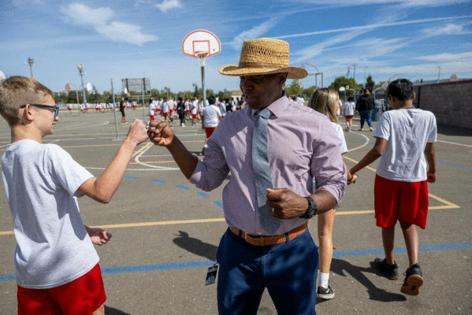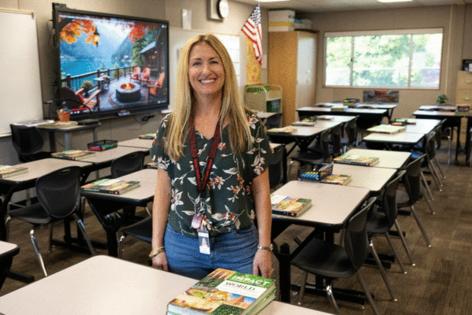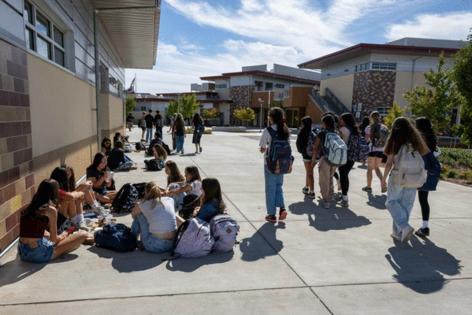This California middle school restricted cellphone use on campus. Was it successful?
Published in News & Features
SACRAMENTO, Calif. — One of the biggest issues administrators at Sutter Middle School in Folsom faced coming back to campus after COVID-19 shutdowns was the prevalence of cellphone use on campus. Online bullying was a daily challenge and tween students — who are in the primetime of their lives for play and relationship building — were glued to their screens during lunch periods, disengaged from their peers seated around them.
Something had to change.
Principal Tarik McFall was a key advocate for restricting cellphone use at Folsom Cordova Unified School District middle schools. He had been through it before, previously leading Albert Einstein Middle School in Sacramento to become a phone-free campus. He had already fielded the complaints and witnessed the ultimate success that implementing restrictions had on campus culture, and he was resolved to take Sutter in the same direction.
The district opted to restrict cellphone use during passing and lunch periods at the beginning of the 2022-23 school year. Two years later, McFall and his staff are claiming great success for their school.
“The difference is palpable,” Assistant Principal Brian Zan said.
Folsom Cordova district leaders took initiative on limiting cellphone use, but the change is impending for all California public schools. In September, Gov. Gavin Newsom signed AB 3216, a bill authored by Republican Assemblymember Josh Hoover of Folsom, which requires school districts to adopt a policy to limit or ban phones on school campuses by July 1, 2026.
Based on the results he’s seen implementing the policy at two schools on opposite sides of the socioeconomic spectrum, McFall welcomes the statewide change.
“I feel like it’s pretty much on one side as far as the benefits versus the cons go,” McFall said. “I think it’s one of those things, like a seatbelt law. Even if you don’t agree, it’s just better for kids.”
The problem and how they fixed it
Middle school students coming back to campus in 2021 were used to being connected with their devices all day. A year of online classes and canceled in-person social activities bred a dependence on their devices, and Sutter Middle was feeling the consequences.
Dealing with bullying on campus is one thing, but managing it when it’s taking place in the ephemeral setting of the online world proved near impossible. McFall described incidents where students used their phones to record one another without their consent, leading to bullying and running the risk of a video from school going viral, as has been the case on campuses across the country.
Students’ attachment to their phones was also hindering their social skills. McFall and Zan said that kids were less engaged with one another during lunch periods, opting to turn to their screens instead of in-person conversation. This led to problems in the classroom, as kids were undersocialized and used to the ritual of pulling their phones out when bored.
“Instead of sitting around at a lunch table visiting, laughing, having a good time or playing basketball and building relationships, it was just kind of sitting looking at their phones, and that’s not good for the mind and body,” social studies teacher Lindsay Castro said.
Like many schools looking to institute cellphone restrictions, the district initially employed Yondr pouches, which secure phones during the day while allowing students to keep the phone on their person. McFall and his staff found that the pouches were more trouble than they were worth as they created extra headaches when it came to monitoring them.
A silver lining of the pouch approach: it established a clear precedent that cellphones were no longer permitted. It helped when, in the following year, administration abandoned the pouches, going forward with a more straightforward approach where phones were to be powered off during school hours. This way, teachers did not have to be responsible for collecting cellphones or monitoring the use of the bags.
It took consistent communication of the policy to students and staff, but teachers have found the effort to be more than worth it.
“They’re turned off — out of sight, out of mind,” Castro said. “I don’t want to be the phone police. It’s great because now we can just spend the 52 minutes we have from bell to bell on learning. … They’re creating, they’re building skills right up until that bell.”
Castro has observed an improvement in students ability to focus and engage with class material since phone use has been banned during passing and lunch periods.
“When I’m standing up there and I have to compete with a phone, it’s tough,” she said. “When you eliminate one of the biggest distractions, it helps them focus, especially for students who already struggle with that.”
Enforcement has proved to be less painful than anticipated. Castro said she no longer knows who does or doesn’t own a phone because they’re not coming out in class. Escalating disciplinary actions related to phone usage are few and far between, McFall said. He estimated that only one student has gotten enough violations to warrant a meeting with the family. Otherwise, parents are understanding when they receive a call home, McFall said, and sometimes recommend that their child turn their phone into the office each day.
Addressing parent concerns
The effort to ban cellphone use during school hours began with communication with families, who were overwhelmingly in favor of stricter rules on devices. Around 10% of Sutter parents, however, were against the policy prior to implementation, citing concerns about safety and their ability to communicate with their kids, McFall said.
This conversation has returned as Folsom Cordova Unified faces a new challenge: the effort to implement the same policy in high schools. At a recent school board meeting, parent Earl Smith expressed his discomfort with the proposed policy, citing his existing difficulty communicating with the school.
“The district in general does not communicate,” Smith said after bringing up the possibility of a school shooting. “You’ve made changes to public transportation and that wasn’t communicated with the community, so how do children at a high school level get about and function?”
The district’s current K-8 mobile device policy allows students to go to the office to text or call their family if they need to get in contact, and parents may call the school if they need to reach their child. Devices are also allowed for students whose special education plans require them.
McFall argues that in his experience, campus has become safer without the constant connection between students and parents.
“I’ve been an administrator for 11 years, and in that time, have been a part of creating multiple safety plans — no safety plan has kids get on their cellphones to call their parents,” he said. “As a matter of fact, most of our law enforcement don’t want lines jammed up or parents running to the campus (during an emergency).”
He also said that administrators are “put at a disadvantage” to address issues as they come up when students contact their parents before telling an adult. When a student is sick or otherwise struggling, school staff don’t have the chance to help them address the problem and build trust between the student and other adults, McFall said.
“It gives peace of mind to the parent when they do come to the school that something is being done, as opposed to coming in with questions that we can’t even answer because the student hasn’t come to us,” he said.
As far as student satisfaction, they, of course, complained at first as well. But McFall thinks that the student body has taken to it and that students are quietly enjoying the more social environment. Castro has heard complaints in her classroom, but welcomes the discourse as a part of her social studies class.
Eighth-grader Vidditi Khanna echoed her principal’s sentiment, saying that the six-hour break from the device is nice.
“Not having a cellphone is kind of refreshing, because you’re away from your phone and you don’t have social media and stuff,” she said.
____
©2024 The Sacramento Bee. Visit at sacbee.com. Distributed by Tribune Content Agency, LLC.












Comments